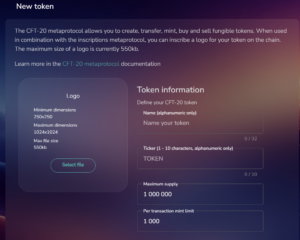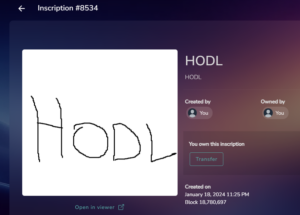The TL/DR for Asteroid Protocol:
- Asteroid Protocol brings inscriptions and fungible tokens to Cosmos blockchain.
- Jointly developed by Delphi Labs and Astroport Foundation.
- Open source framework includes various tools for exploring, token deployment, and minting.
- Connect your Keplr wallet to inscribe data or mint tokens.
- Offers substantially more power than alternatives, supporting larger files (up to 550 kb).
- Use at your own risk – software and specifications are experimental and unaudited.
- Features include an indexer, explorer, API, Cosmos Fungible Token (CFT-20) specification, token deployer, minting tool, and software.
- Compatible with Keplr wallet, enables data inscription and/or CFT-20 token minting, including the world’s first CFT-20, ROIDS
Drawing inspiration from Bitcoin Inscriptions/Ordinals, BRC-20 tokens, and working in conjunction with Delphi Labs, Asteroid Protocol recently launched to bring the world of open-source everything to Cosmos Hub.
The cool thing about inscriptions is that unlike NFTs, which often live in data storage services, inscriptions live on-chain forever. In addition to the data living on-chain, inscriptions also create new fee structures for validators on Cosmos, which lacks native token support and smart contracts. Hence Asteroid Protocol was born – now anyone can create a token and inscribe data onto Cosmos blockchain.
Key Components
At the time of writing, Asteroid Protocol is made up of three key components: Cosmos Fungible Tokens (CFT-20s), Inscriptions, and a Marketplace.
CFT-20
The CFT-20 token standard describes how to create, mint, and transfer fungible tokens using the Asteroid metaprotocol framework. It is derived from the initial BRC-20 standard, but essentially literally anyone can go into Asteroid Protocol and create a fungible (tradable and exchangeable) token. I was so interested in this concept that I had to try it for myself.
All you have to do is log into Asteroid, click on CFT-20 Tokens on the left-hand side, then click Create. You will be directed to a screen that looks like this:

Give your token a name – this is important because thousands of tokens have already been created. You want something that stands out, is meme-able, and memorable. I chose to name my token Good Game because it’s a popular saying in the crypto community and also very memorable and has multiple meanings.
Once you come up with a name, then create a logo for the token. This can easily be done if you have ChatGPT4. There are multiple logo creators in the DALLE section of the custom GPTs. Then give your token a ticker; I chose $GGM for my token. Choose the max supply, how many tokens can be minted at one time, and whether you want your token to launch immediately or sometime in the future. Keep in mind, if you choose a low number of tokens to be minted at one time, you, or someone else, will have to hit the mint button a lot to fully mint the max supply.
That’s it, you have now created a CFT-20 token that’s able to be minted and traded on the Marketplace.

Inscriptions
This was the first service provided by Asteroid Protocol. The key difference is that the inscriptions on Cosmos are extremely cheap – sometimes only $.10 or so, depending on the day. The process is easy – click on the Inscriptions tab on the far left, then click Create, and you will be brought to a screen that looks like this:

Select the file from your computer, name it, and give it a description, then click inscribe. That’s it, you’re done, and now your image or whatever you inscribed is living on the Cosmos blockchain forever. Some excellent inscription collections are emerging as well; take a look at some of the top collections mentioned in this Tweet. I’m partial to the Cosmos Shrooms, and there is even a story about Shroom #28 that’s worth investigating. I also took the opportunity to inscribe a very important message:

Marketplace
At the time of writing, the marketplace is only for trading CFT-20 tokens. But I’ve seen multiple suggestions on Twitter for an inscription marketplace, so I’m sure that is in the works.
Click on Marketplace in the lower left-hand side, then click CFT-20 tokens. You will be brought to a screen that looks like this:

You can click on any of the tokens and look to see what people are selling. The tokens are sold similarly to BRC-20 tokens; they are listed in certain amounts for preset prices. Oh hey, did you happen to see that Good Game is listed on page 1? Anyway, when you click on a token you want to buy you will see a screen like this:

To combat “double buys” Asteroid has implemented the following solution, “…we’ve rolled out a unique deposit model… First, buyers place a tiny deposit (0.01%-1% of the total cost). Once that’s confirmed, they send the full payment within the time displayed in the UI, and they’re all done! In some cases, another purchaser may send a deposit seconds before you. If that happens, and they finalize their purchase, you forfeit your deposit. While not ideal, losing out on a tiny deposit is far better than losing out on the full purchase price for your transaction!”
You can read more about the buying process in this Tweet. Also, I’d highly recommend browsing their full Twitter page to see what else they’ve been building and the possibilities they’ve been exploring. I think they will be innovating for a long time, and people really like how accessible and cost-friendly the protocol is. It might not have that much volume for smaller coins yet, but we have to remember that Ordinals didn’t become popular overnight either. It might be a great time to get into Asteroid Protocol early.
Cheers!
This is a Contributor Post. Opinions expressed here are opinions of the Contributor. Influencive does not endorse or review brands mentioned; does not and cannot investigate relationships with brands, products, and people mentioned and is up to the Contributor to disclose. Contributors, amongst other accounts and articles may be professional fee-based.

